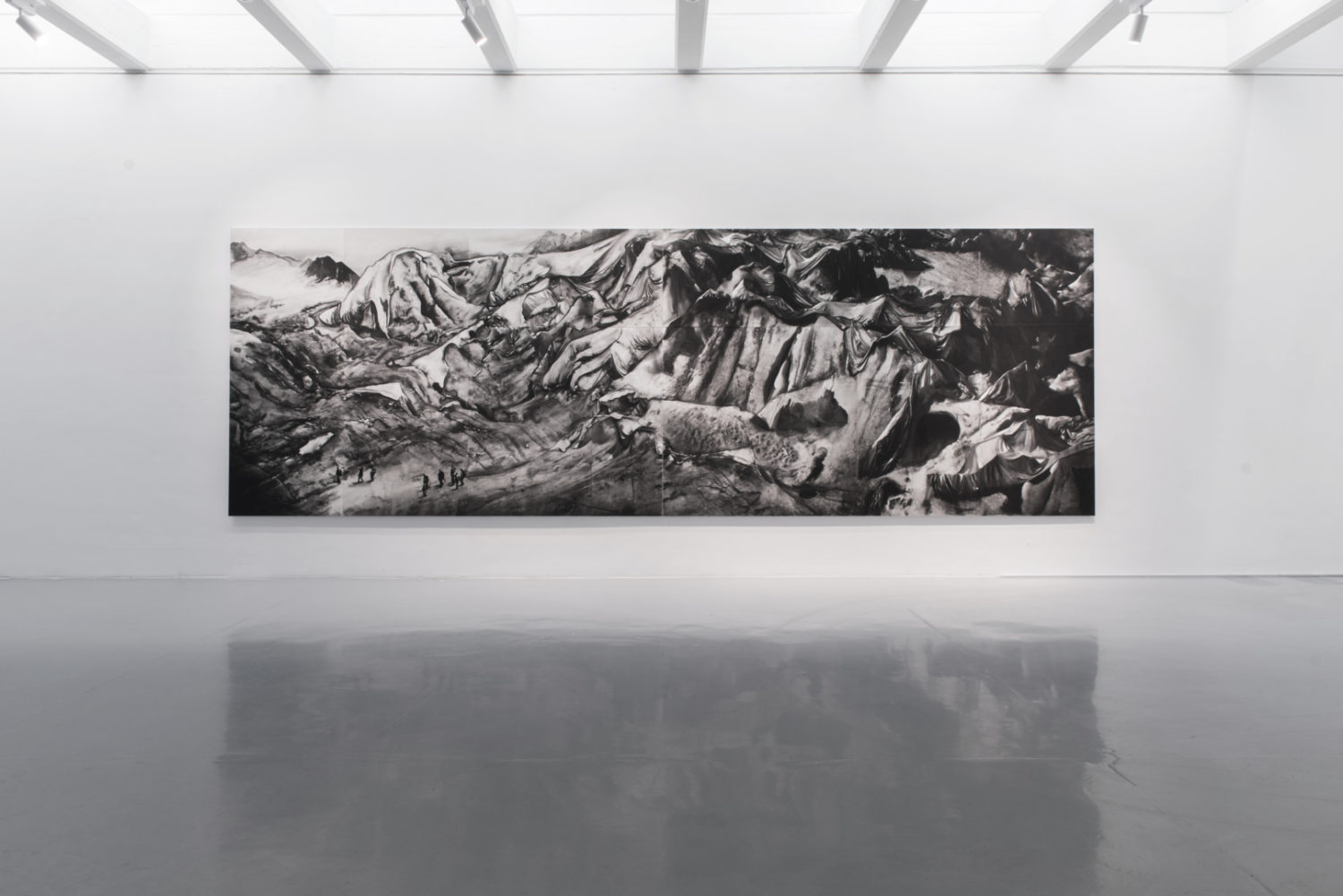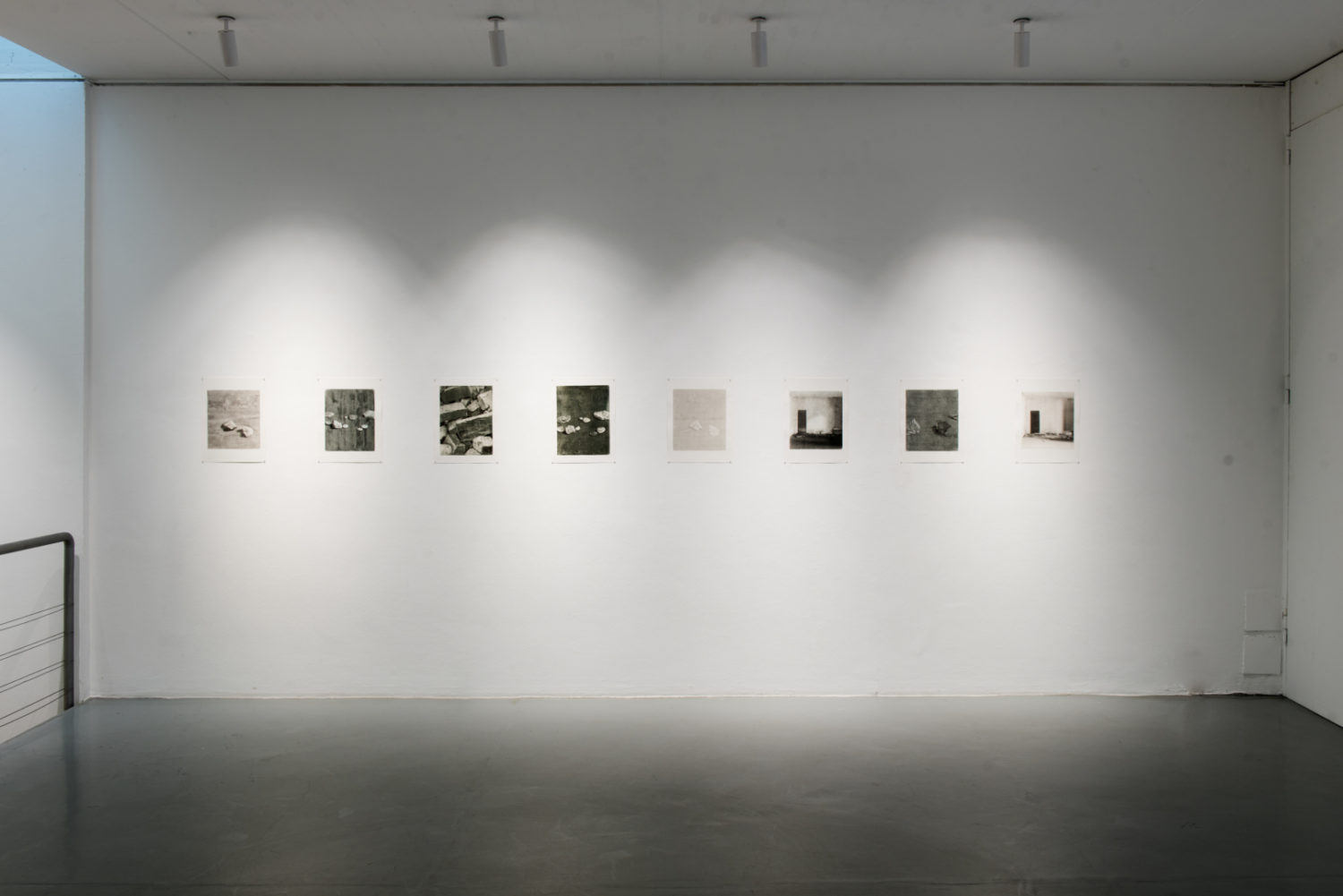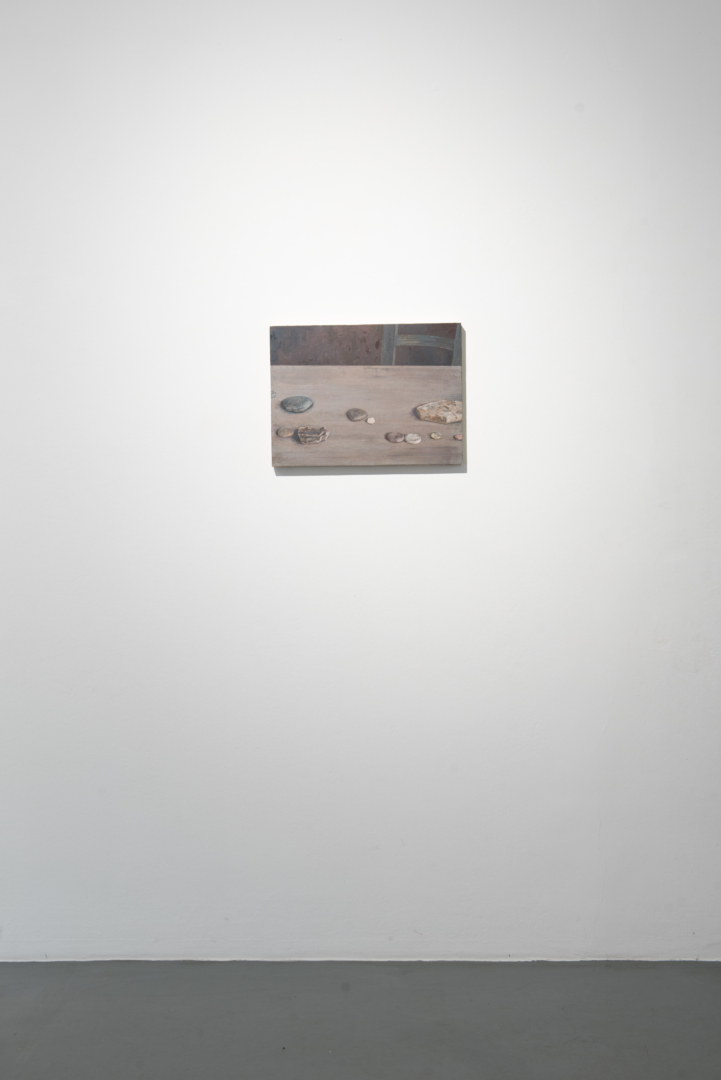FIELDS OF EMOTIONAL HABITS
Albrecht Schäfer – Radenko Milak
April 5, 2019 – August 23, 2019
Die Doppelausstellung bei PRISKA PASQUER präsentiert zwei Künstler, die sich der Welt mit klassischen malerischen Mitteln annähern. Die kleinformatigen Ölbilder und Monotypien von ALBRECHT SCHÄFER (*1967, Stuttgart) entstehen aus der Betrachtung realer Objekte im Raum, die schwarz-weißen Aquarelle von RADENKO MILAK (*1980, Travnik, Bosnien) basieren auf zeitgenössischen und kunsthistorischen Bildquellen.
Die parallele Präsentation dieser beiden Positionen führt exemplarisch das Potenzial zeitgenössischer Bildproduktion vor Augen. Während sich ALBRECHT SCHÄFER zurückgezogen im geschlossenen Kosmos seines Ateliers auf kleine analoge Gegenstände wie Steine oder ein architektonisches Modell konzentriert, filtert RADENKO MILAK aus der Masse vorhandener Bilder signifikante Motive heraus und interpretiert diese neu. Speziell für die Ausstellung hat er ein monumentales, 2 x 6 Meter messendes Aquarell geschaffen, das einen Gegenpol bildet zu SCHÄFERs kleinen Ölbildern.
Doch so verschieden künstlerischer Ansatz, Entstehungsprozess, Technik, Formate und Motive auch sind – letztendlich kreisen die Werke beider Künstler um das Kleine im Großen und das Große im Kleinen, die zusammen genommen das große Ganze ergeben.
ALBRECHT SCHÄFER
Mir reicht das Licht, das an einer Wand entlang streicht. (Albrecht Schäfer)
ALBRECHT SCHÄFER ist bekannt für seine konzeptuellen Skulpturen und Interventionen im architektonischen Raum. Der Künstler, der an der Weißensee Kunsthochschule Berlin eine Professur für Bildhauerei innehat, stellte seine skulpturalen Werke unter anderem in der Kunsthalle Mannheim, im KW Institute for Contemporary Art, Berlin, sowie im Leverkusener Museum Morsbroich aus. Daher war die Überraschung groß, als er vor drei Jahren erstmals kleinformatige, in Öl gemalte „Interieurs“ präsentierte. Vorangegangen war ein radikaler Rückzug aus dem Ausstellungsbetrieb. Eine intensive Phase der Neubesinnung, die ihn zu einer kompletten Änderung seiner Arbeitspraxis führte.
Statt raumgreifender Konstruktionen und skulpturaler Arrangements entstehen nun zweidimensionale Bilder. Impulsgeber für diese Werke sind nicht mehr konkrete Ausstellungsprojekte, besondere Räumlichkeiten und spezifische Konstellationen. Anstatt sich an immer neuen Architekturen „abzuarbeiten“, konzentriert sich der SCHÄFER jetzt ausschließlich auf seinen Atelierraum. Auch die verschiedenen Alltagsgegenstände wie Zeitung, Dachlatte, Jalousie oder Lampe, die zuvor sein Werk geprägt haben, sind verschwunden. An ihre Stelle getreten sind Steine, seit neuestem auch einzelne Laubblätter.
Das Atelier ist Entstehungsort und zugleich Motiv von SCHÄFERS neuer Malerei. Der schlichte, kleine Raum ist für ihn weniger ein Ort physischer Interaktion, als vielmehr Gegenstand der Kontemplation. Anschauungsobjekt ist ein kleines Modell, das SCHÄFER als „Interieur“ in Öl malt. Wechselnde Perspektiven, Lichtverhältnisse und Möblierungen sind ihm Anlass genug für immer neue Interpretationen des Sujets. Die Palette seiner kleinformatigen Gemälde ist gedämpft. Es überwiegen beige, erdige, rosa und graue Töne.
In ähnlichen Farben gehalten ist auch die Serie der „Steine“. SCHÄFER malt Allerweltssteine: Kieselsteine und Backsteine, runde und kantige Steine, Reste aus Kernbohrungen, Fundstücke von Baustellen. Nichts an diesen Steinen ist besonders. Es sind autarke Objekte, und SCHÄFER schaut sie in ihrem So-Sein an. Er betrachtet ihre Form, ihre Farbigkeit, die Struktur ihrer Oberfläche. Auf seinen Gemälden und Monotypien sind die Steine zu lockeren Gruppen arrangiert, manchmal auf indifferentem Grund, manchmal auch auf Sockeln.
Licht und Schatten, Raum und Zeit sind die Konstanten im Werk von ALBRECHT SCHÄFER. Ebenso die Arbeit mit einfachen Dingen und schlichten Materialien. Dies gilt auch für seine neuen Arbeiten, die auf der Basis radikaler Reduktion und Konzentration entstehen. Es ist sicher kein Zufall, dass SCHÄFER auf diesem Weg zu traditionellen Techniken und Genres gefunden hat. In der Zurückgezogenheit seines Ateliers stellt er sich den Herausforderungen seines Gegenübers und überführt Objekte und räumliche Situationen Pinselstrich für Pinselstrich in moderne Malerei.
PRISKA PASQUER zeigt Ölbilder und Monotypien von ALRBRECHT SCHÄFER aus den Jahren 2015-2019.
RADENKO MILAK
Meine Malerei ist eine Reaktion auf die Bedrängnis durch all die Bilder, die uns umgeben. Dies ist der eigentliche Bereich meiner emotionalen Gewohnheiten, auf den ich oft zurückkomme. (Radenko Milak)
Im digitalen Zeitalter hat sich ein dramatischer Wandel vollzogen. Von einer Zivilisation, in welcher der Text dominierte, sind wir in die Epoche des Bildes übergegangen. Wenn wir die heutige Welt betrachten, können wir die Intensität der Bilder in unserem Alltag beobachten. RADENKO MILAK analysiert die Rolle der zeitgenössischen Bildproduktion für die Herausbildung unseres historischen und kulturellen Gedächtnisses. Dabei rekurriert er nicht nur auf moderne Bilder, sondern auch auf Werke der Kunstgeschichte und des Kinos. Ausgangspunkt seines monumentalen Aquarells „When I Was A Glacier“ sind dokumentarische Aufnahmen des vom Klimawandel bedrohten Rhonegletschers in den Schweizer Zentralalpen. Hier versuchen Umweltaktivisten, die fortschreitende Eisschmelze zu verlangsamen, indem sie den Gletscher im Sommer mit weißem Vlies abdecken.
RADENKO MILAK zeigt den durch die alpinen Felsformationen fließenden Gletscher aus der Vogelperspektive. Große Partien des Firns sind mit Planen bedeckt, die sich wie gigantische Hussen über die gefährdeten Eismassen legen. Links im Bild sind zehn Personen zu erkennen. Sie haben dem Berg den Rücken zugekehrt und steigen hinab ins Tal. Vor der imposanten Bergkulisse wirken diese Menschen so winzig und verloren, dass man fast nicht glauben mag, dass der Mensch der Verursacher der globalen Erderwärmung ist, der die eiszeitlichen Gletscher zum Opfer fallen
In seinem malerischen Werk befasst sich RADENKO MILAK immer wieder mit Bildern von Katastrophen. Bereits sein erstes großes, 365 Aquarelle zu Ereignissen des 20. Jahrhunderts umfassendes Projekt „365“ (2014) enthielt überraschend viele Darstellungen von Unglücken. 2017 entwickelte MILAK für seine Einzelausstellung im Pavillon von Bosnien und Herzegowina auf der 57. Biennale Venedig das multidisziplinär angelegte Projekt „University of Disaster“. Im Zentrum standen vier großformatige, komplex komponierte Aquarelle zu verschiedenen, von Menschen herbeigeführten Desastern.
An diese Arbeiten knüpft das monumentale, speziell für die Ausstellung bei PRISKA PASQUER entstandene Panel an. In dem 2 x 6 Meter messenden Aquarell lädt MILAK die dokumentarischen Fotovorlagen mit weiteren bildnerischen Referenzen auf, darunter Pieter Bruegels Gemälde „Jäger im Schnee“ (1565) sowie Filme des deutschen Regisseurs Arnold Fanck aus den 1920er-Jahren. „When I Was A Glacier“ ist ein hochaktuelles Sinnbild für das dramatisch aus dem Gleichgewicht geratene Verhältnis von Mensch und Natur. Zugleich ist es eine moderne Interpretation des Berges als religiöses und spirituelles Symbol.
Ergänzend werden in der Ausstellung weitere Aquarelle von RADENKO MILAK präsentiert, die sich mit Katastrophen, moderner Wissenschaft und dem Blick des Menschen auf die Welt befassen. Ausgangspunkt der Werkserien sind mikroskopische Aufnahmen von Nanostrukturen („Mikro“) sowie Fotografien, die mit dem Hubble Weltraumteleskops aufgenommen wurden („Makro“).
This dual exhibition at GALERIE PRISKA PASQUER presents two artists who approach the world through classical painterly means. The small-format oil paintings and monotypes by ALBRECHT SCHÄFER (b. 1967 in Stuttgart) stem from the observation of real objects in space; the black-and-white watercolors by RADENKO MILAK (b. 1980 in Travnik, Bosnia) are based on contemporary and art-historical image sources.
The parallel presentation of these two positions clearly demonstrates the potential of contemporary image production. Whereas ALBRECHT SCHÄFER withdraws into the closed cosmos of his studio to concentrate on small, analog objects such as stones or an architectural model, RADENKO MILAK filters out significant motifs from the masses of existing images and interprets them anew. Especially for this exhibition, he created a monumental watercolor measuring 2 x 6 meters, which forms a counterpole to SCHÄFER’s small oil paintings.
Yet as different as their approaches, creative processes, techniques, formats and subjects are, in the end, both artists’ works revolve around the small within the large and the large within the small – which, taken together, form the bigger picture.
ALBRECHT SCHÄFER
It is enough for me to simply see light streaming across a wall. (Albrecht Schäfer)
ALBRECHT SCHÄFER is known for his conceptual sculptures and interventions in architectural space. The artist, who holds a professorship in sculpture at the Weißensee Academy of Art Berlin, has exhibited his sculptural works at such venues as the Kunsthalle Mannheim, the KW Institute for Contemporary Art in Berlin and the Morsbroich Museum in Leverkusen. Thus, when he first presented his series of small-format oil paintings, “Interiors,” three years ago, they were received with great surprise. The move was preceded by a radical retreat from the exhibition world – and an intensive phase of reflection which led him to completely change his way of working.
Instead of extensive constructions and sculptural arrangements, he now produced two-dimensional images. The incentives for these works were no longer concrete exhibition projects, unique spaces and specific constellations. Rather than constantly slaving away in new architectural settings, SCHÄFER now concentrated exclusively on his small studio space. The various everyday objects that previously characterized his work – such as newspapers, roof battens, blinds or lamps – have also disappeared. Stones have now entered to take their place, as well as, most recently, single leaves.
In SCHÄFER’s new painted works, the atelier is both a place of creation as well as a subject. For him, the small, plain room is less a place for physical interaction than an object for contemplation. His object of study is a small model, which SCHÄFER paints as an “interior” in oil. Changing perspectives, light conditions and furnishings are sufficient grounds for him to reinterpret the subject over and over. The palette of his small-format paintings is muted: primarily beige, earthy, pink and gray tones.
He maintains a similar color range in the series “Stones.” SCHÄFER paints ordinary stones: gravel and bricks, round and angular stones, debris from bore holes, found objects from construction sites. They are autarkic objects, and SCHÄFER observes them in “as-is” form. He observes their shape, their coloration, the structure of their surfaces. In his paintings and monotypes, the stones are arranged in loose groupings – sometimes against an indifferent background, but sometimes on pedestals.
Light and shadow, space and time are the constants in ALBRECHT SCHÄFER’s work – as are his work with simple objects and plain materials. This is also true of his new works, which are the result of radical reduction and concentration. It is certainly no coincidence that in this process, SCHÄFER found his way to traditional techniques and genres. In the seclusion of his studio, he rises to the challenge of his interlocutor and transposes objects and spatial situations into modern painting, brushstroke by brushstroke.
GALERIE PRISKA PASQUER presents oil paintings and monotypes by ALBRECHT SCHÄFER from the period 2015‒2019.
RADENKO MILAK
My painting is a reaction to the oppression we experience from all the images that surround us. This is the actual realm of my emotional habits, to which I often return. (Radenko Milak)
A dramatic change has taken place in the digital age: from a civilization in which text was dominant, we have moved into the epoch of the image. When we look at the world today, we can observe the intensity of the images in our everyday life. RADENKO MILAK analyzes the role of contemporary image production in the formation of our historic and cultural memory. In doing so, he refers back not only to modern images, but also to works of art history and cinema. The starting point for his monumental watercolor When I Was a Glacier is documentary footage of the Rhône Glacier in the central Swiss Alps, which is currently threatened by climate change. Here, climate activists attempt to slow the progress of the melting ice by covering the glacier with a white fleece in the summertime.
RADENKO MILAK depicts the glacier’s flow through the Alpine rock formations from a bird’s eye view. Large portions of the firn are covered with tarps, stretched over the endangered masses of ice like furniture covers. Ten people can be seen in the left part of the image. They have turned their backs on the mountain and are descending into the valley. Against the imposing backdrop of the mountains, these people appear so tiny and lost that we can scarcely believe human beings are the cause of that global warming process to which the Ice-Age glaciers are falling victim.
In his painted works, RADENKO MILAK repeatedly deals with images of disasters. His first large project, 365 watercolors illustrating events of the twentieth century, entitled 365 (2014) includes a surprisingly large number of depictions of catastrophes. In 2017, for his solo exhibition at the Bosnia and Herzegovina pavilion at the 57th Venice Biennale, MILAK developed his multidisciplinary project “University of Disaster.” At its center stood four large-format, intricately composed watercolors depicting different disasters brought about by human beings.
Carrying the theme of these works forward is the monumental panel created especially for the exhibition at GALERIE PRISKA PASQUER. In this 2 x 6-meter watercolor, MILAK tops up the original documentary photography with additional pictorial references, including Pieter Bruegel’s painting Hunters in the Snow (1565) and films by the German director Arnold Fanck dating from the 1920s. When I Was a Glacier is a highly topical symbol of the relationship between human beings and nature, which has slid dramatically out of balance. At the same time, it is a modern interpretation of the mountain as a religious and spiritual symbol.
In addition, the exhibition presents further watercolors by RADENKO MILAK that deal with themes of catastrophe, modern science and human beings’ view of the world. The points of departure for these series of works are microscopic images of nanostructures (“Micro”) as well as photographs taken by the Hubble Space Telescope (“Macro”).



















